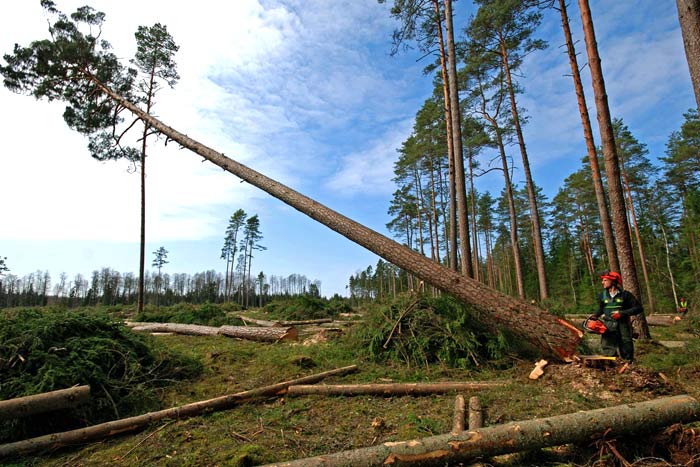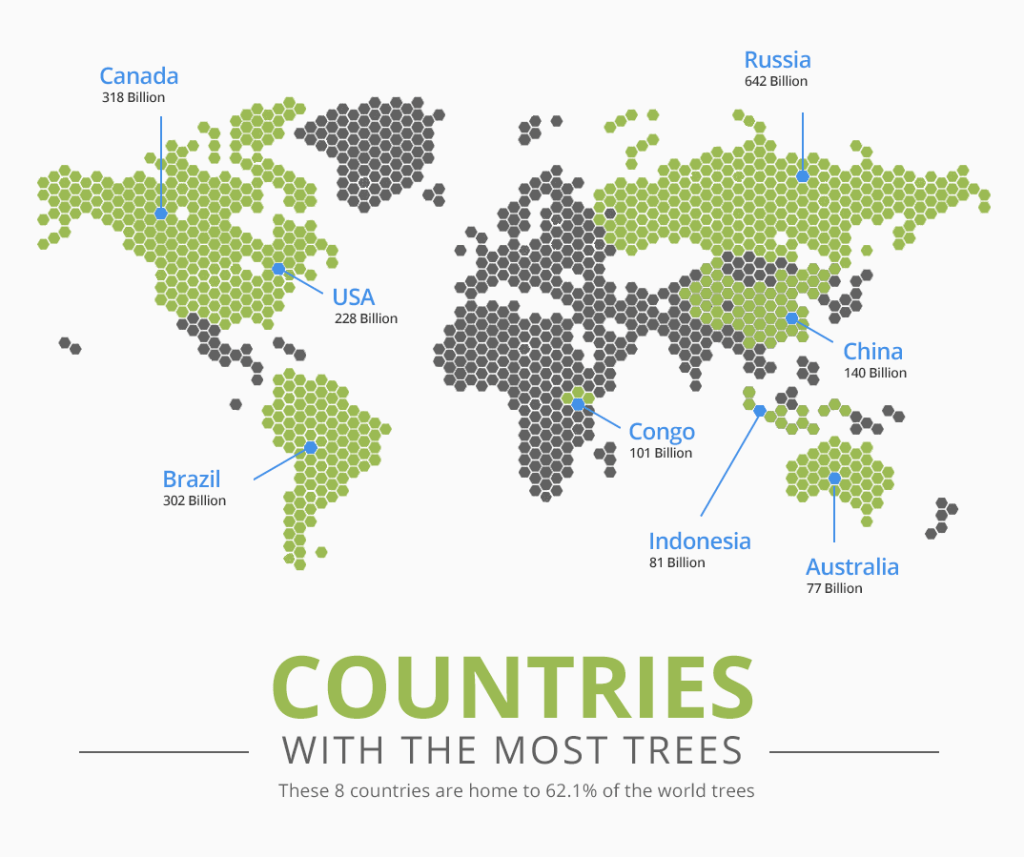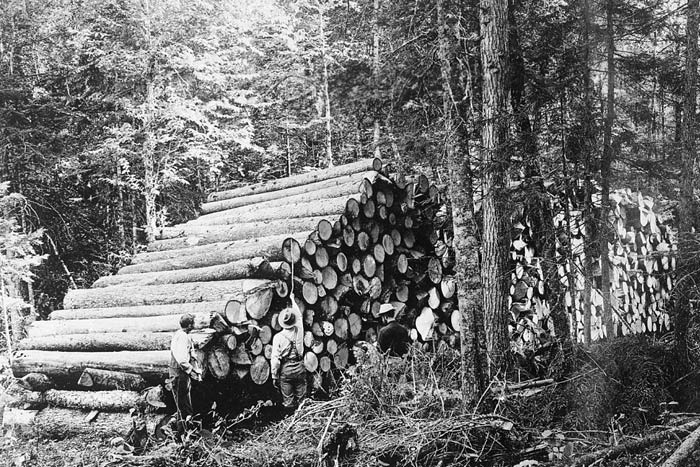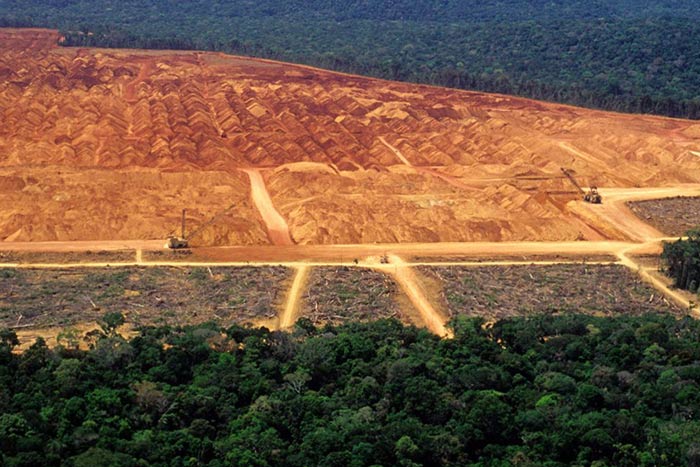The act of cutting down trees has been a significant and longstanding practice on our planet. It is crucial to take into account the scope and area of tree cutting, alongside the reasons for which the trees are cut.

Between 3.5 billion to 7 billion trees are being cut every year according to a report1 published by the Rainforest Action Network (RAN). The United Nations Environment Programme (UNEP)’s 2020 The State of the World’s Forests report2 also indicates that about 420 million hectares of forest have been cleared in the past 30 years which is equivalent to about 12 million hectares of forest per year.
While a significant percentage of tree cutting is done for necessary economic activities, there is certainly a need to take stock of the current forest cover and track the felling of trees for various reasons. For this, a clear picture of the number of trees currently on the planet vis a vis the tree-cutting figures is required.
What we cover
ToggleNumber of Trees on The Planet
According to the UNEP report referenced above, approximately 31% of the global land area is covered by forests. This excludes trees growing in non-forested areas such as cities and private homesteads. In total, an estimated 3 trillion trees are growing on the planet, according to a 2015 scientific study3. More importantly, the report also shows that almost half (45.8%) of the planet’s tree cover has been lost due to deforestation over the decades.
Using a combination of satellite imagery and ground surveys, scientists were able to paint an accurate picture of the number of trees on the planet in 2015. The figures can be confirmed using other estimates by organizations such as UNEP, WEP, and independent environmental research groups. Unlike other studies published in the past, this one is not only peer-reviewed but also used modern techniques and technologies to gather the data.
Here is a breakdown of some of the countries with the highest number of trees according to the study:
| Position | Country | Number of Trees |
|---|---|---|
| 1 | Russia | 642 Billion trees |
| 2 | Canada | 318 Billion Trees |
| 3 | Brazil | 302 Billion Trees |
| 4 | United States of America | 228 Billion trees |
| 5 | China | 140 Billion trees |

As expected, the countries with the largest landmass and relatively better economies top the list with the highest number of trees per square meter. Below is a summary of the countries with the least number of trees. As expected, the countries in this list are either small island nations or those in arid and semi-arid parts of the world.
| Position | Country | Number of Trees |
|---|---|---|
| 189 | Paracel Islands | 12 Thousand Trees |
| 190 | Monaco | 10 Thousand Trees |
| 191 | Cocos Islands | 6 Thousand Trees |
| 192 | Bahrain | 3 Thousand Trees |
| 193 | Clippeton Island | 0 Trees |
| 194 | Spratly Islands | 0 Trees |
| 195 | Vatican City | 0 Trees |
The last three countries on the list were considered to have no trees at all based on ground data. If any, most of them either have no vegetation or forest land.
Number of Trees Removed in The Last 100 Years
There are several non-peer-reviewed studies out there that claim to have a clear picture of the deforestation that has occurred over the last century. While these figures cannot be verified for obvious reasons, such as there being no tree-cutting studies as recently as fifty years ago, some of the studies use a mixture of rudimentary estimations and empirical data to paint a picture of the past decade’s deforestation and can be relied upon.

According to the UN, Food and Agricultural Organisation (FAO) forest report State of the World’s Forests4 2020, there has been a 13% decrease in forest cover over the past 100 years. This, therefore, equates to approximately 3.9 billion trees removed in the past 100 years. In total, about 0.6 billion hectares of forest cover were removed or lost through natural means between 1800 to 2010. Below is a graph showing deforestation figures in the past 100 years according to the UN report.
In the same report, it is estimated that over 3 trillion trees (equal to the current tree cover) have been cleared by humankind since the beginning of civilization. However, it’s also important to point out the fact that some countries have managed to match or surpass the ratio of trees being felled versus those being planted.
For instance, the United States which happens to host approximately 8% of the world’s forests has more trees now than it had a century ago. The country’s harvest-to-planting ratio has been positive since the 1940s. The same cannot be said of other countries, though, hence the need to continue encouraging tree planting and less deforestation around the world.
Percentage of Trees Cut Down Each Year
Approximately 3.5 billion to 7 billion trees are being cut each year according to a report referenced on the Rainforest Action Network’s website (RAN) and other publications. Given the current estimate of the total tree cover on the planet, that could equate to about 0.11% of trees being cut each year.
However, empirical research by environmental bodies such as UNEP tends to use landmass as opposed to individual tree counts to estimate the rate of deforestation. As such, the State of the World’s Forests report under Global Forest Resources Assessment 2020 indicates that approximately 10 million hectares of tree cover are being lost to deforestation every year.
Top Reasons for Trees Being Cut Down
As the rate of deforestation continues to increase in some parts of the world, it’s also important to note the reasons behind it. Tree cutting is mostly done for commercial reasons like the demand for more agricultural land in some areas. Here then, are some of the top reasons why trees are being cut down today:
1. Timber Harvesting
Timber harvesting currently accounts for 37% of tree cutting around the world according to a report by IntactForests.org. However, a big percentage of the timber harvesting is being done on commercially grown forests except in developing countries and those with significant indigenous forest covers such as Brazil and DR Congo.
2. Agricultural Expansion
The need to have more agricultural land has always been a big contributor to deforestation around the world. Approximately 28% of tree cutting is being done for agricultural expansion with underdeveloped and developing countries leading. FAO estimated almost two decades ago that in two-thirds of the countries with expanding agricultural land, forest areas were sharply declining.
Large-scale farming is the main driver behind rapid deforestation in Latin America and some emerging economies such as Indonesia while small-scale agriculture continues to contribute to deforestation in Africa. With growing populations and demand for more food and natural resources, it is difficult to address the issue of deforestation where agricultural expansion is involved.
3. Wildfires
With changing climatic conditions and increased human encroachment into forest reserves, there has been a steady increase in the number of forest fires in recent years. To date, wildfires account for approximately 21% of trees being lost each year around the world.
4. Road Construction, mining, and other human activities
These account for 12% of trees being cut around the world to pave for projects such as road and rail constructions, road expansions, mining activities, and similar human activities.
Major Impacts of Mass Deforestation

There is no doubt that mass deforestation has had a massive impact on the planet with climate change being the biggest one. Here are some of the major impacts of mass deforestation as identified by environment scientists over the years:
1) Mass Deforestation destroys habitats
Without forests, most living things depending on the forests for survival lose their natural habitats. This can have devastating effects on life on the planet ranging from human-animal conflict to mass extinctions. Indeed, the planet has lost a number of its animals, birds, and other living organisms as a result of deforestation and mass extinction.
2) Deforestation Contributes to Climate Change
There is a very clear link between massive deforestation in some parts of the world and climate change characterized by disappearing lakes, dried rivers, rising sea levels, flooding, landslides, and other harsh weather conditions.
3) Desertification, Soil Erosion, and Wildfires
Massive deforestation is the reason behind extreme soil erosion in some areas, which has a negative and long-term effect on farming. In the long run, deforestation leads to desertification and more frequent wildfires.
Get more numbers on trees and helpful tips to save the trees in your own backyard here. We have articles on tree maintenance, trimming techniques, and much more.
Number of Trees Being Replanted to Offset Deforestation
Over the years, environmental organizations and groups have managed to highlight the importance of reforestation. As a result, many countries have taken the initiative to plant more trees each year to offset deforestation.
A recent study5 by Scientists at the University of Maryland indicates that roughly eight hundred thousand square miles of tree cover has been added since 1982. This is a good effort but environmental experts still estimate that we need to plant at least a billion hectares of tree cover by 2050 to curb global warming and other effects of deforestation.
What would happen if we cut down all the trees in the world?
Needless to say, the result of cutting down all the trees in the world would not be good. We would have uncontrollable flooding, soil erosion, and a complete collapse of the land-based ecosystem.
There will be less ability of the earth to recapture CO2 which would make the air more toxic.
- Rainforest Action Network, (2017) How many trees are cut down every year? <https://www.ran.org/the-understory/how_many_trees_are_cut_down_every_year/#:~:text=3.5%20billion%20to%207%20billion%20trees%20are%20cut%20down%20per%20year.> Accessed: 17-02-2024
- United Nations Environment Programme, (2020) The State of the World’s Forests: Forests, Biodiversity and People. <https://www.unep.org/resources/state-worlds-forests-forests-biodiversity-and-people> Accessed: 17-02-2024
- Crowther, T., Glick, H., Covey, K. et al, (2015) Mapping tree density at a global scale. <https://www.nature.com/articles/nature14967> Accessed: 17-02-2024
- Food and Agriculture Organization of the United Nations, (2009) State of the World’s Forests 2009. <https://openknowledge.fao.org/server/api/core/bitstreams/3463127c-125b-4294-8b4b-db7111b5fe1a/content> Accessed: 17-02-2024
- Song, XP., Hansen, M.C., Stehman, S.V. et al, (2018) Global land change from 1982 to 2016. <https://www.nature.com/articles/s41586-018-0411-9> Accessed: 17-02-2024




